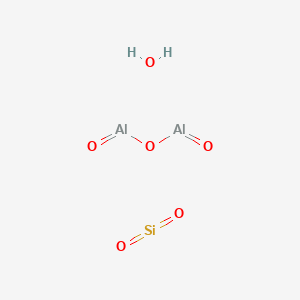



1. Bentone 34
2. Dimethyldioctadecylammonium Montmorillonite
3. Ivy Block
4. Quaternium 18-bentonite
1. Benclay
2. Bentolite L
3. Bentone 34
4. Aquagel
5. Askangel
6. Magbond
7. Otaylite
8. Tixoton
9. Volclay
10. Wilkinite
11. Bengel
12. Culvin
13. Filgel
14. Akajo
15. Asama
16. Bentogrout
17. Soap Clay
18. Bentonit T
19. Bentolite Hs
20. Bulgarben Ba
21. Accugel F
22. Altonit Sf
23. Bengel A
24. Bengel Fw
25. Southern Bentonite
26. Bengel Hvp
27. Bentosolon 82
28. Aquagel Gold Seal
29. Detercal G 1fc
30. Detercal G 2fc
31. Detercol P 2
32. Bentone 27
33. Accofloc 352
34. Cosintam 403
35. Hi-jel
36. Bengel 11
37. Bengel 15
38. Bengel 23
39. Bentonite 2073
40. Bentone 660
41. Cvis
42. Fulbent 570
43. Volcaly Bentonite Bc
44. Aluminosilicate Hydrate
45. Imvite I.g.b.a
46. Bentonite [jan:nf]
47. Bentonite, Sodium Form
48. Panther Creek Bentonite
49. Clarit Bw 100
50. Clarit Bw 125
51. Black Hills Bh 200
52. Bentonite, Calcian-sodian
53. Unii-a3n5zcn45c
54. G 100 (clay)
55. Ex 0030 (clay)
56. Albagel Premium Usp 4444
57. Ccris 3663
58. Hsdb 392
59. Gk 129sa3
60. Gk 129sa5
61. Aeg 325
62. Ex-m 703
63. Einecs 215-108-5
64. Mfcd00130611
65. Ex 0276
66. 250m
67. Dioxosilane;oxo(oxoalumanyloxy)alumane;hydrate
68. Q20817027
| Molecular Weight | 180.06 g/mol |
|---|---|
| Molecular Formula | Al2H2O6Si |
| Hydrogen Bond Donor Count | 1 |
| Hydrogen Bond Acceptor Count | 6 |
| Rotatable Bond Count | 0 |
| Exact Mass | 179.925141 g/mol |
| Monoisotopic Mass | 179.925141 g/mol |
| Topological Polar Surface Area | 78.5 Ų |
| Heavy Atom Count | 9 |
| Formal Charge | 0 |
| Complexity | 52.4 |
| Isotope Atom Count | 0 |
| Defined Atom Stereocenter Count | 0 |
| Undefined Atom Stereocenter Count | 0 |
| Defined Bond Stereocenter Count | 0 |
| Undefined Bond Stereocenter Count | 0 |
| Covalently Bonded Unit Count | 3 |
| 1 of 2 | |
|---|---|
| Drug Name | Ivy block |
| Active Ingredient | Bentoquatam |
| Dosage Form | Lotion |
| Route | Topical |
| Strength | 5% |
| Market Status | Over the Counter |
| Company | Stand Homeopath |
| 2 of 2 | |
|---|---|
| Drug Name | Ivy block |
| Active Ingredient | Bentoquatam |
| Dosage Form | Lotion |
| Route | Topical |
| Strength | 5% |
| Market Status | Over the Counter |
| Company | Stand Homeopath |
Used to prevent or reduce the severity of allergic contact dermatitis due to urushiol, the allergenic resin of poison ivy, poison oak, and poison sumac.
Bentoquatam protects the skin like a shield against poison ivy, poison oak, and poison sumac by physically blocking skin contact with their resin. The best protection against getting these conditions is to avoid contact with these plants. This medicine does not dry oozing and weeping caused by the rash of poison ivy, poison oak, or poison sumac.
Dermatologic Agents
Drugs used to treat or prevent skin disorders or for the routine care of skin. (See all compounds classified as Dermatologic Agents.)
The mechanism of action is unknown. It is thought topically applied bentoquatam acts as a physical barrier that interferes with the adsorption of antigens onto the skin and reduces absorption of antigens into the skin. It probably does not work by modifying the systemic allergic response.
